Off-Design Performance Prediction of a S-CO2 Turbine Based on Field Reconstruction Using Deep-Learning Approach
Abstract
Featured Application
Abstract
1. Introduction
- The performance of field reconstruction for an end-to-end deep learning method is explored in this research. The most existing machine learning methods only focus on one target variable in engineering design and optimization tasks. The fields predicted by our method can provide more flow mechanism explanations and help designers understand the physical process.
- The data-based proxy model is established for a physical system. Traditional methods lack accuracy to some extent and require manual intervention. Based on the existing scientific database, this method does not need to rely on human intervention and has the advantages of being universal, flexible, and easy to implement, showing a good promise for real-time control and design optimization of turbines.
- The method proposed in this research is effective and accurate. The off-design power and efficiency prediction in this method is able to reach performance comparable to a state-of-the-art model and clearly outperforms classical methods. In addition, once the deep model is well-trained, the calculation with GPU-accelerated can quickly predict the physical fields on the blade surface and turbine performance.
2. Theory and Method
2.1. Overall Architecture
2.2. CFD Analysis Method
2.3. Deep Convolutional Neural Network
3. Results and Discussion
3.1. CFD Off-Design Pre-Analysis
3.2. Physical Field Reconstruction
- Stagnation phenomenon of high temperature and high pressure in the S_LE.
- The local acceleration of S_LE due to the large curvature change results in a small area of low pressure and low temperature.
- The tip clearance of rotor blade is affected by the pressure difference between both rotor blade sides and the larger negative impact angle. This causes the working fluid in the tip clearance to accelerate from the pressure side to the suction side. Therefore, the pressure and temperature near the tip of the rotor blade will be relatively low.
- The flow separation due to deviation from the design condition. It is worth noting that the flow in these regions is very complex, so the corresponding prediction error will increase accordingly. However, the error is still small, completely within the acceptable range.
3.3. Performance Prediction
4. Conclusions
- The design and optimization of a 60,000 rpm S-CO2 turbine were completed based on our previous research. The output power of the designed turbine is 1019 kW and the total static efficiency is 89.44%.
- At stage 1, the field reconstruction was conducted on 1000 off-design cases with varying design variables. The physical fields were plausibly predicted and all key typical phenomena in turbine were captured. The average relative error of the field is less than 1.5%, while the maximum relative error is less than 15%.
- Based on the reconstructed physical field, the off-design performance of the S-CO2 turbine was predicted accurately at stage 2. The relative error of predicted power and efficiency are between −5% and +5%. Moreover, the relative error of efficiency is concentrated in the ±1% range.
- Compared with other five classic data prediction methods, XGboost, KNN, RF, SVR, and MLP, the off-design power and efficiency prediction in this method clearly outperforms classical methods and comparable to a state-of-the-art model.
- In addition, once the deep model is well-trained, the calculation with GPU-accelerated can quickly predict the physical fields on the blade surface and turbine performance.
Author Contributions
Funding
Conflicts of Interest
References
- Gil, L.; Lacarra, S.O.; Embid, J.M.; Gallardo, M.A.; Blanco, S.T.; Artal, M.; Velasco, I. Experimental setup to measure critical properties of pure and binary mixtures and their densities at different pressures and temperatures: Determination of the precision and uncertainty in the results. J. Supercrit. Fluid 2008, 44, 123–138. [Google Scholar] [CrossRef]
- Crespi, F.; Gavagnin, G.; Sanchez, D.; Martinez, G.S. Supercritical carbon dioxide cycles for power generation: A review. Appl. Energy 2017, 195, 152–183. [Google Scholar] [CrossRef]
- Xie, Y.H.; Wang, Y.Q.; Zhang, D.; Shi, D.B. Review on Research of Supercritical Carbon Dioxide Brayton Cycle and Turbomachinery. Proc. Chin. Soc. Electr. Eng. 2018, 38, 7276–7286. [Google Scholar]
- Li, M.J.; Zhu, H.H.; Guo, J.Q.; Wang, K.; Tao, W.-Q. The development technology and applications of supercritical CO2, power cycle in nuclear energy, solar energy and other energy industries. Appl. Therm. Eng. 2017, 126, 255–275. [Google Scholar] [CrossRef]
- Manente, G.; Fortun, F.M. Supercritical CO2 power cycles for waste heat recovery: A systematic comparison between traditional and novel layouts with dual expansion. Energy Convers. Manag. 2019, 197, 111777. [Google Scholar] [CrossRef]
- Sun, L.; Wang, Y.; Wang, D.; Xie, Y. Parametrized Analysis and Multi-Objective Optimization of Supercritical CO2(S-CO2) Power Cycles Coupled with Parabolic Trough Collectors. Appl. Sci. 2020, 10, 3123. [Google Scholar] [CrossRef]
- Kim, D.Y.; Kim, Y.T. Preliminary design and performance analysis of a radial inflow turbine for ocean thermal energy conversion. Renew. Energy 2017, 106, 255–263. [Google Scholar] [CrossRef]
- Wright, S.; Radel, R.; Vernon, M.; Pickard, P. Operation and Analysis of a Supercritical CO2 Brayton Cycle; Sandia National Laboratories: Livermore, CA, USA, 2010.
- Cho, J.; Choi, M.; Baik, Y.J.; Lee, G.; Ra, H.-S.; Kim, B.; Kim, M. Development of the turbomachinery for the supercritical carbon dioxide power cycle. Int. J. Energy Res. 2016, 40, 587–599. [Google Scholar] [CrossRef]
- Zhou, A.; Song, J.; Li, X.; Ren, X.; Gu, C. Aerodynamic design and numerical analysis of a radial inflow turbine for the supercritical carbon dioxide Brayton cycle. Appl. Therm. Eng. 2018, 132, 245–255. [Google Scholar] [CrossRef]
- Han, W.; Zhang, Y.; Li, H.; Yao, M.; Wang, Y.; Feng, Z.; Zhou, N.; Dan, G. Aerodynamic design of the high pressure and low pressure axial turbines for the improved coal-fired recompression SCO2 reheated Brayton cycle. Energy 2019, 179, 442–453. [Google Scholar] [CrossRef]
- Luo, D.; Liu, Y.; Sun, X.; Huang, D. The design and analysis of supercritical carbon dioxide centrifugal turbine. Appl. Therm. Eng. 2017, 127, 527–535. [Google Scholar] [CrossRef]
- Yu, Y.; Chen, L.; Sun, F.; Wu, C. Neural-network based analysis and prediction of a compressor’s characteristic performance map. Appl. Energy 2007, 84, 48–55. [Google Scholar] [CrossRef]
- Rossi, M.; Renzi, M. A general methodology for performance prediction of Pumps-as-Turbines using Artificial Neural Networks. Renew. Energy 2018, 128, 265–274. [Google Scholar] [CrossRef]
- Palagi, L.; Sciubba, E.; Tocci, L. A neural network approach to the combined multi-objective optimization of the thermodynamic cycle and the radial inflow turbine for Organic Rankine cycle applications. Appl. Energy 2019, 237, 210–226. [Google Scholar] [CrossRef]
- Sarafraz, M.M.; Safaei, M.R.; Goodarzi, M.; Arjomandi, M. Experimental investigation and performance optimisation of a catalytic reforming micro-reactor using response surface methodology. Energy Convers. Manag. 2019, 199, 111983. [Google Scholar] [CrossRef]
- Sarafraz, M.M.; Tlili, I.; Tian, Z.; Bakouri, M.; Safaei, M.R. Smart optimization of a thermosyphon heat pipe for an evacuated tube solar collector using response surface methodology (RSM). Physica A 2019, 534, 122146. [Google Scholar] [CrossRef]
- Sarafraz, M.M.; Safaei, M.R.; Jafarian, M.; Goodarzi, M.; Arjomandi, M. High Quality Syngas Production with Supercritical Biomass Gasification Integrated with a Water–Gas Shift Reactor. Energies 2019, 12, 2591. [Google Scholar] [CrossRef]
- Guo, X.; Li, W.; Iorio, F. Convolutional Neural Networks for Steady Flow Approximation. In Proceedings of the 22nd ACM SIGKDD International Conference on Knowledge Discovery and Data Mining (KDD), San Francisco, CA, USA, 13–17 August 2016. [Google Scholar]
- Jin, X.; Cheng, P.; Chen, W.L.; Li, H. Prediction model of velocity field around circular cylinder over various Reynolds numbers by fusion convolutional neural networks based on pressure on the cylinder. Phys. Fluids 2018, 30, 047105. [Google Scholar] [CrossRef]
- Ti, Z.L.; Deng, X.W.; Yang, H.X. Wake modeling of wind turbines using machine learning. Appl. Energy 2020, 257, 114025. [Google Scholar] [CrossRef]
- Paszke, A.; Gross, S.; Chintala, S.; Chanan, G.; Yang, E.; DeVito, Z.; Lin, Z.; Desmaison, A.; Antiga, L.; Lerer, A. Automatic differentiation in PyTorch. In Proceedings of the NIPS Autodiff Workshop, Long Beach, CA, USA, 9 December 2017. [Google Scholar]
- Gao, K.K.; Xie, Y.H.; Zhang, D. Effects of stator blade camber and surface viscosity on unsteady flow in axial turbine. Appl. Therm. Eng. 2017, 118, 748–764. [Google Scholar] [CrossRef]
- Shi, D.B.; Zhang, L.; Xie, Y.H.; Zhang, D. Aerodynamic Design and Off-design Performance Analysis of a Multi-Stage S-CO2 Axial Turbine Based on Solar Power Generation System. Appl. Sci. 2019, 9, 714. [Google Scholar] [CrossRef]
- Menter, F.R. Two-equation eddy-viscosity turbulence models for engineering applications. AIAA J. 1994, 32, 1598–1605. [Google Scholar] [CrossRef]
- Winhart, B.; Sinkwitz, M.; Schramm, A.; Engelmann, D.; Di Mare, F.; Mailach, R. Experimental and Numerical Investigation of Secondary Flow Structures in an Annular Low Pressure Turbine Cascade Under Periodic Wake Impact—Part 2: Numerical Results. J. Turbomach. 2019, 141, 021009. [Google Scholar] [CrossRef]
- Mojaddam, M.; Hajilouy-Benisi, A.; Moussavi-Torshizi, S.A.; Movahhedy, M.R.; Durali, M. Experimental and numerical investigations of radial flow compressor component losses. J. Mech. Sci. Technol. 2014, 28, 2189–2196. [Google Scholar] [CrossRef]
- Zeiler, M.D.; Krishnan, D.; Taylor, G.W.; Fergus, R. Deconvolutional networks. In Proceedings of the IEEE Computer Vision and Pattern Recognition, San Francisco, CA, USA, 13–18 June 2010. [Google Scholar]
- Zeiler, M.D.; Taylor, G.W.; Fergus, R. Adaptive deconvolutional networks for mid and high level feature learning. In Proceedings of the IEEE Computer Vision and Pattern Recognition, Colorado Springs, CO, USA, 21–23 June 2011. [Google Scholar]
- Zeiler, M.D.; Fergus, R. Visualizing and understanding convolutional networks. In Proceedings of the Computer Vision—ECCV 2014: 13th European Conference, Zurich, Switzerland, 6–12 September 2014. [Google Scholar]
- Shelhamer, E.; Long, J.; Darrell, T. Fully Convolutional Networks for Semantic Segmentation. IEEE Trans Pattern Anal. Mach. Intell. 2017, 39, 640–651. [Google Scholar] [CrossRef]
- Radford, A.; Metz, L.; Chintala, S. Unsupervised representation learning with deep convolutional generative adversarial networks. In Proceedings of the 4th International Conference on Learning Representations (ICLR 2016), Caribe Hilton, San Juan, Puerto Rico, 2–4 May 2016. [Google Scholar]
- Krizhevsky, A.; Sutskever, I.; Hinton, G. ImageNet Classification with Deep Convolutional Neural Networks. In Proceedings of the Advances in Neural Information Processing Systems, Lake Tahoe, NV, USA, 3–6 December 2012. [Google Scholar]
- Simonyan, K.; Zisserman, A. Very Deep Convolutional Networks for Large-Scale Image Recognition. In Proceedings of the ICLR 2015: International Conference on Learning Representations 2015, San Diego, CA, USA, 7–9 May 2015. [Google Scholar]
- Li, K.P.; Wu, Z.Y.; Peng, K.C.; Ernst, J.; Fu, Y. Tell Me Where to Look: Guided Attention Inference Network. In Proceedings of the 31st IEEE/CVF Conference on Computer Vision and Pattern Recognition (CVPR), Salt Lake City, UT, USA, 18–23 June 2018. [Google Scholar]
- Ioffe, S.; Szegedy, C. Batch normalization: Accelerating deepnetwork training by reducing internal covariate shift. In Proceedings of the International Conference on Machine Learning, Lille, France, 6–11 July 2015. [Google Scholar]
- He, K.M.; Zhang, X.Y.; Ren, S.Q.; Sun, J. Deep Residual Learning for Image Recognition. In Proceedings of the IEEE Conference on Computer Vision and Pattern Recognition (CVPR), Las Vegas, NV, USA, 27–30 June 2016. [Google Scholar]
- Boureau, Y.L.; Bach, F.; Yann, L.C.; Ponce, J. Learning Mid-Level Features for Recognition. In Proceedings of the IEEE Conference on Computer Vision and Pattern Recognition (CVPR), San Francisco, CA, USA, 13–18 June 2010. [Google Scholar]
- Glorot, X.; Bordes, A.; Bengio, Y. Deep Sparse Rectifier Neural Networks. J. Mach. Learn. Res. 2011, 15, 315–323. [Google Scholar]
- Kingma, D.; Ba, J. Adam: A Method for Stochastic Optimization. In Proceedings of the ICLR 2015: International Conference on Learning Representations 2015, San Diego, CA, USA, 7–9 May 2015. [Google Scholar]
- Hinton, G.; Srivastava, N. Neural Networks for Machine Learning Overview of Mini-Batch Gradient Descent. Available online: https://www.cs.toronto.edu/~tijmen/csc321/slides/lecture_slides_lec6.pdf (accessed on 17 May 2019).
- Hadgu, A.T.; Nigam, A.; Diaz-Aviles, E. Large-scale learning with AdaGrad on Spark. In Proceedings of the IEEE International Conference on Big Data, Santa Clara, CA, USA, 29 October–1 November 2015. [Google Scholar]
- Shi, D.B.; Liu, T.Y.; Xie, Y.H.; Zhang, D. Design and Optimization of an S-CO2 Turbine Based on Gauss Process Regression. Chin. J. Power Eng. 2019, 39, 876–883. [Google Scholar]
- Shi, D.B.; Wang, Y.Q.; Xie, Y.H.; Zhang, D. The Influence of Flow Passage Geometry on the Supercritical Carbon Dioxide Centrifugal Compressor. Therm. Sci. 2017, 22, 253. [Google Scholar]
- Shi, D.B.; Xie, Y.H. Aerodynamic Optimization Design of a 150 kW High Performance Supercritical Carbon Dioxide Centrifugal Compressor without a High Speed Requirement. Appl. Sci. 2020, 10, 2093. [Google Scholar] [CrossRef]
- Fan, W.; Zhao, R.C.; Han, Z.H.; Wang, Z. Optimization of design parameters and thermodynamic design for radial flow turbine of organic working fluid. Acta Energy Sol. Sin. 2017, 38, 2309–2316. [Google Scholar]
- Wu, Z.Y.; Fang, X.J. Research on Variable Geometry Low Pressure Turbine Aerodynamic Performance. J. Propuls. Power 2018, 39, 269–276. [Google Scholar]
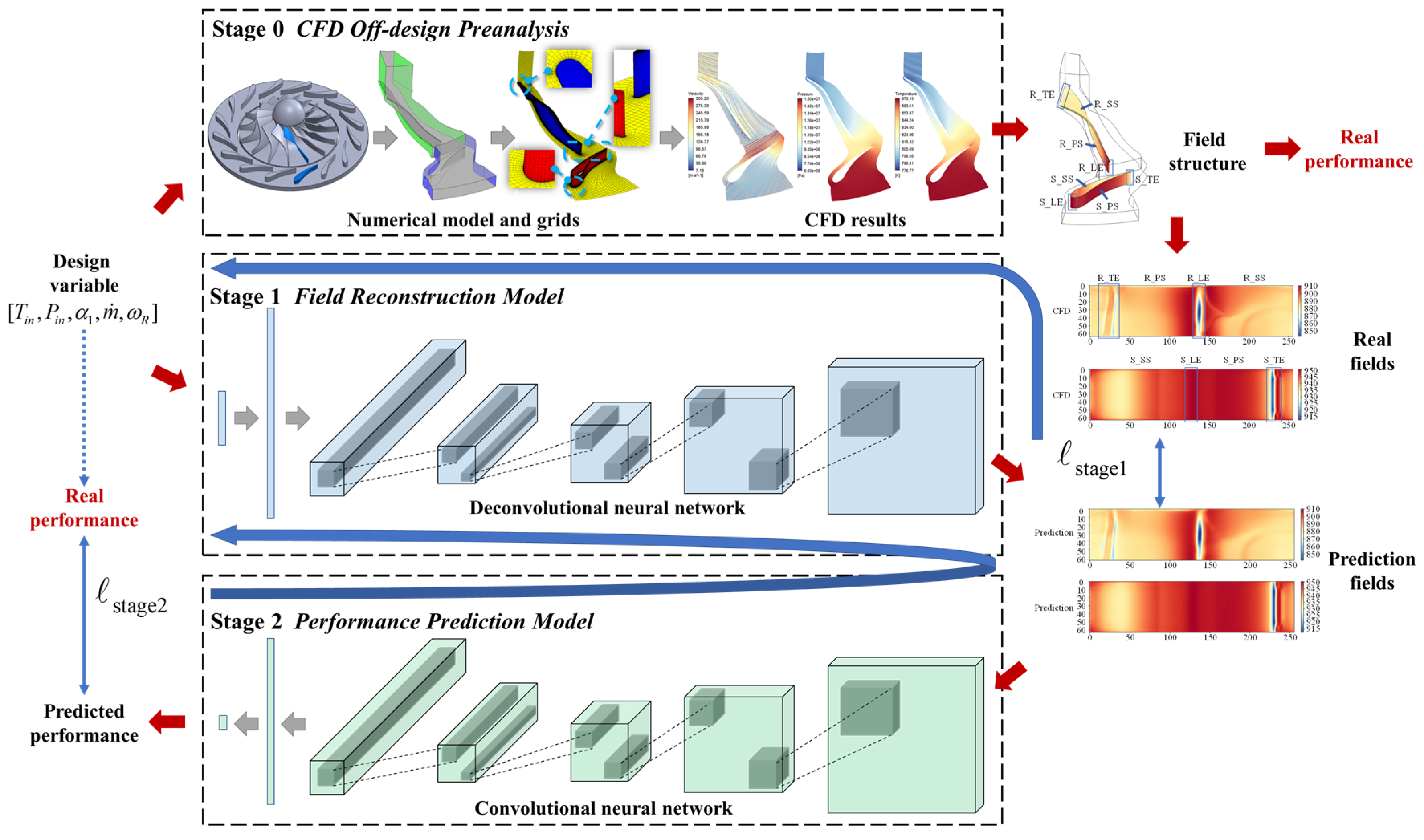
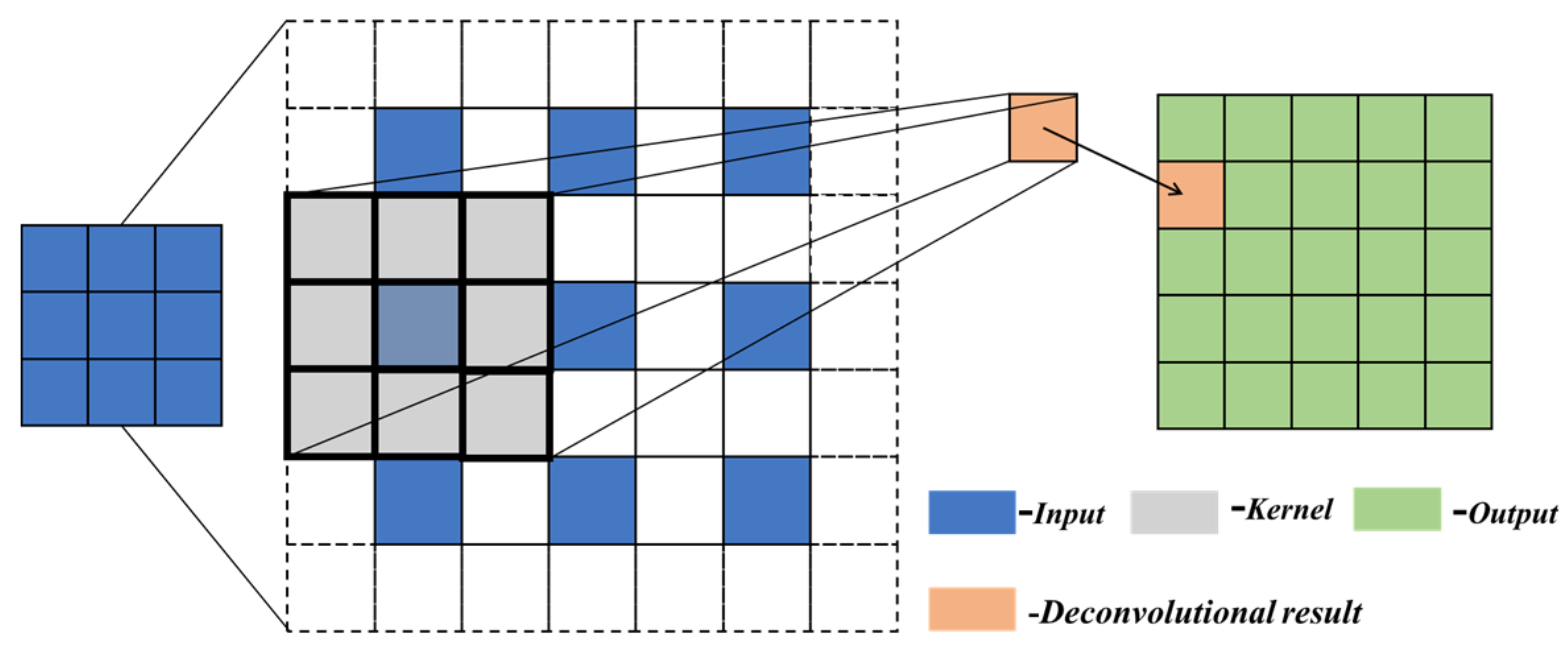
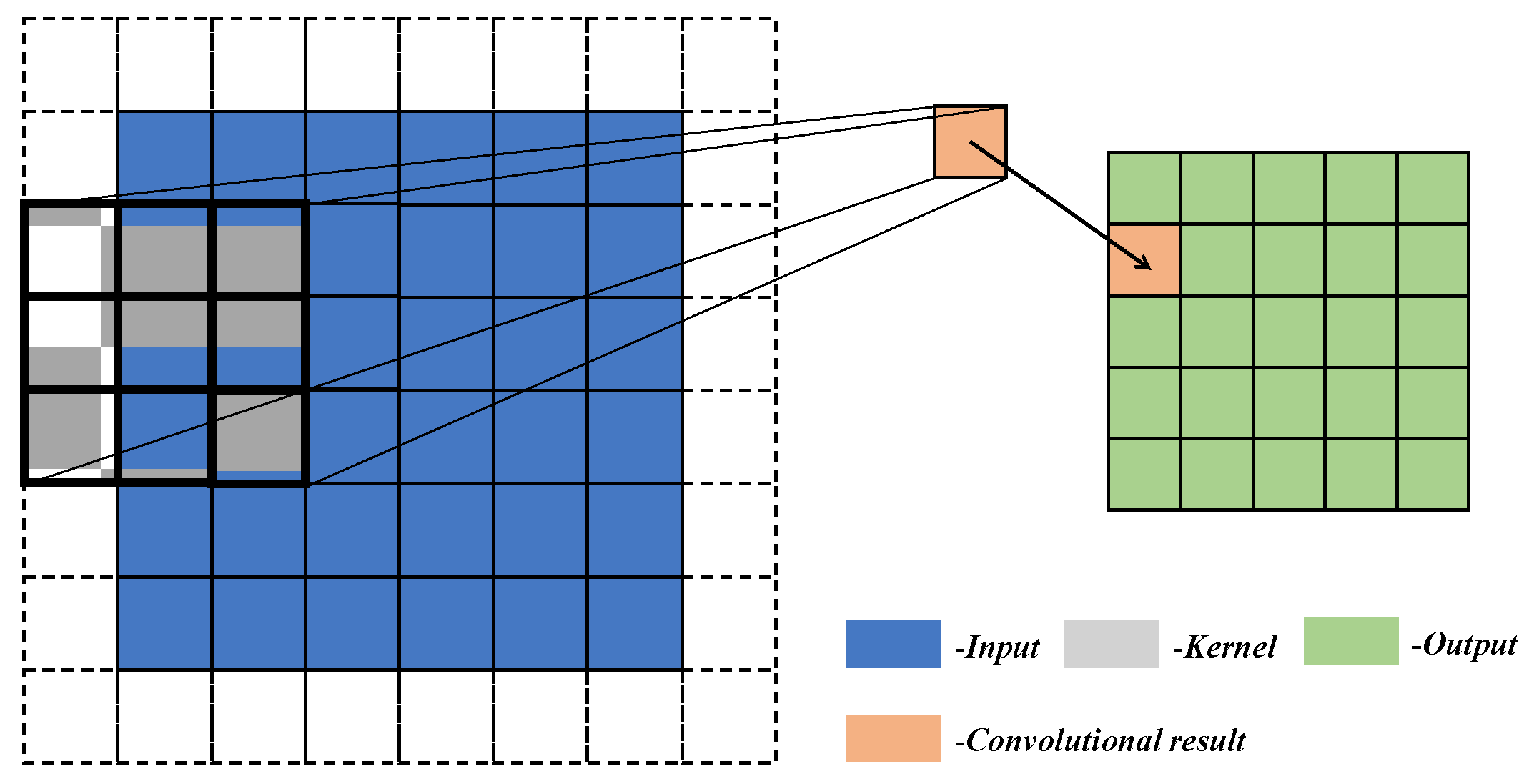
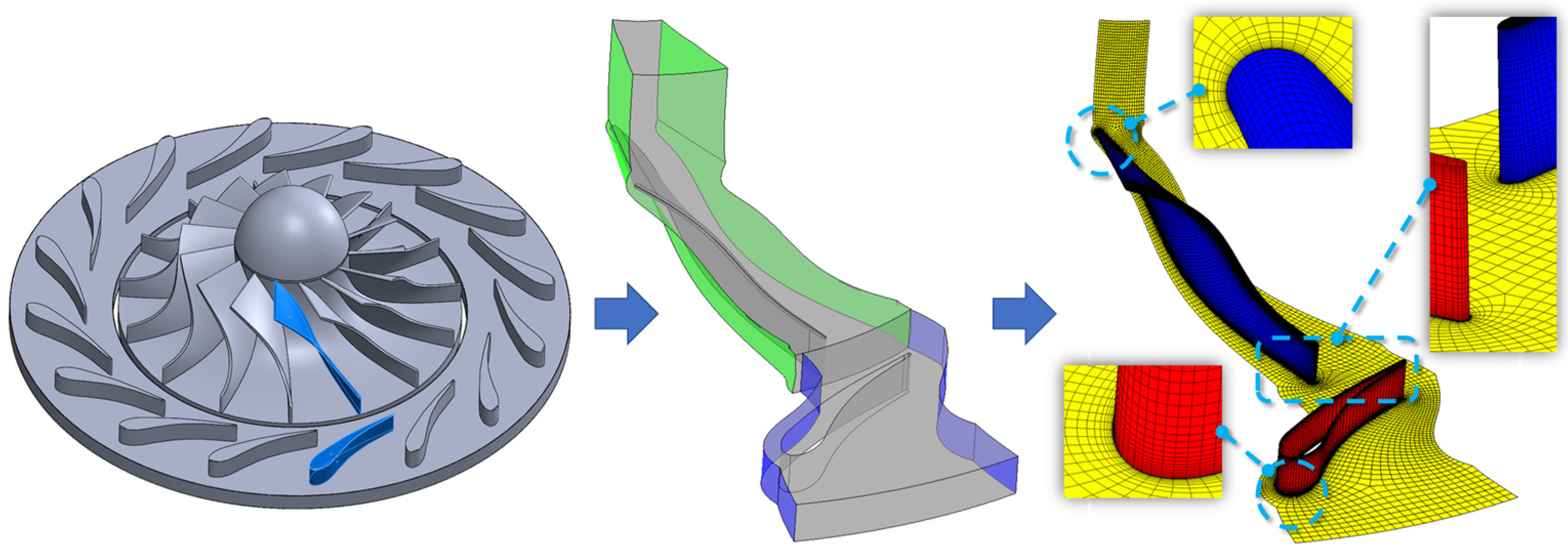
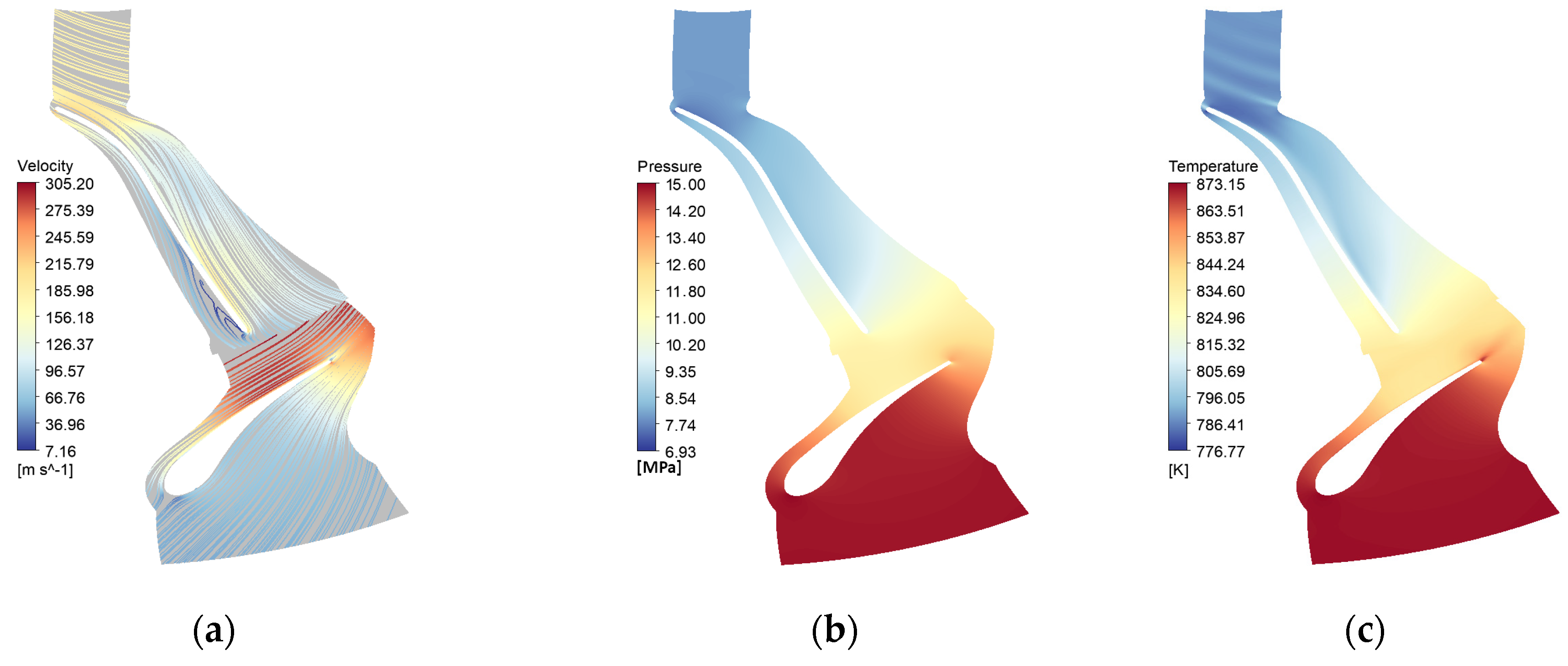
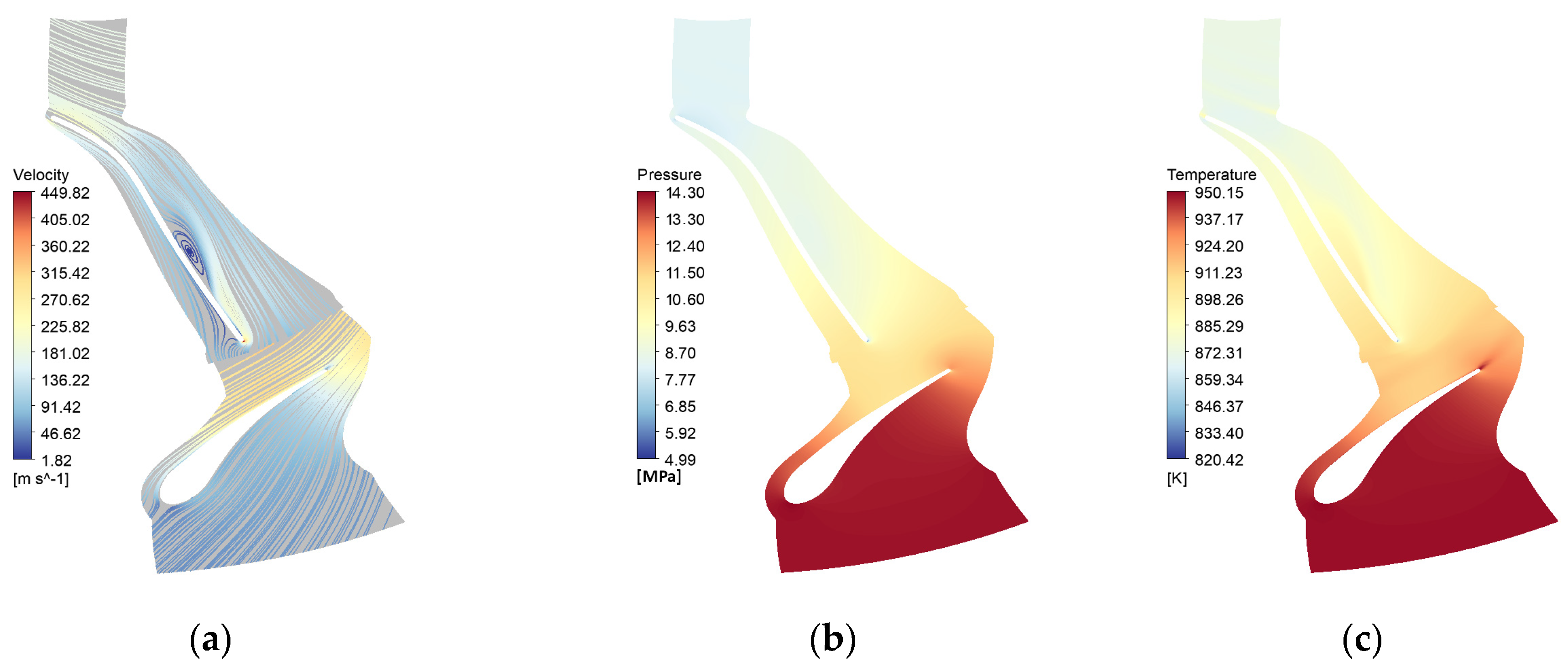
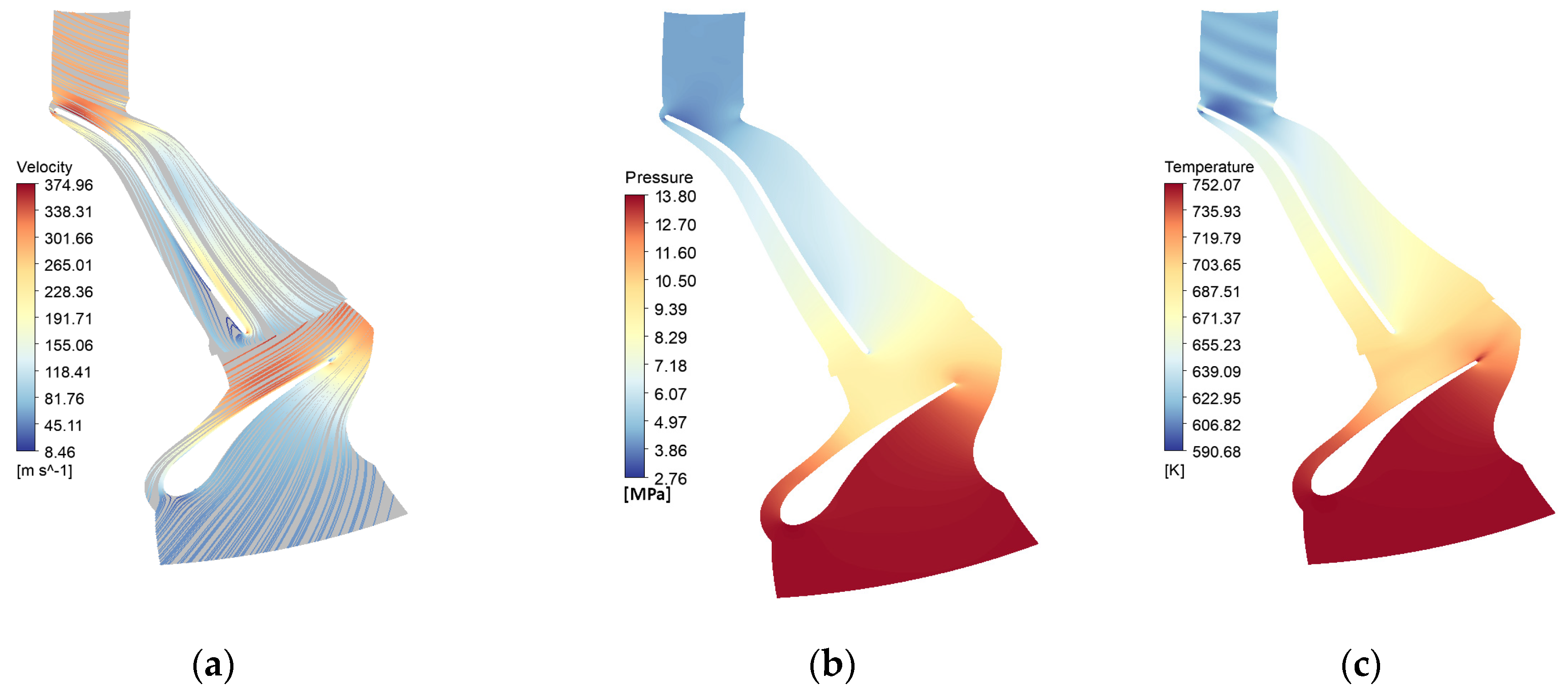
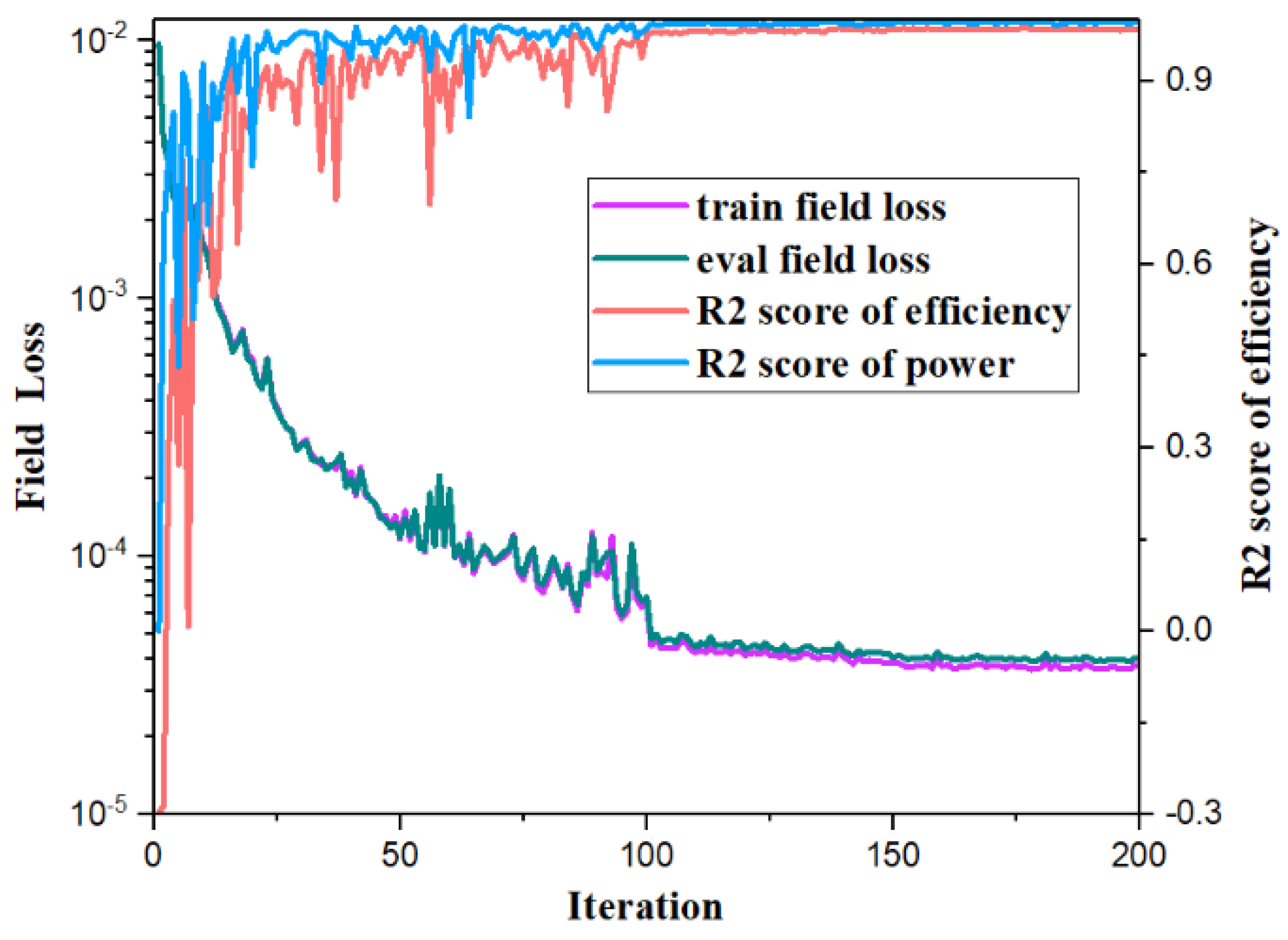
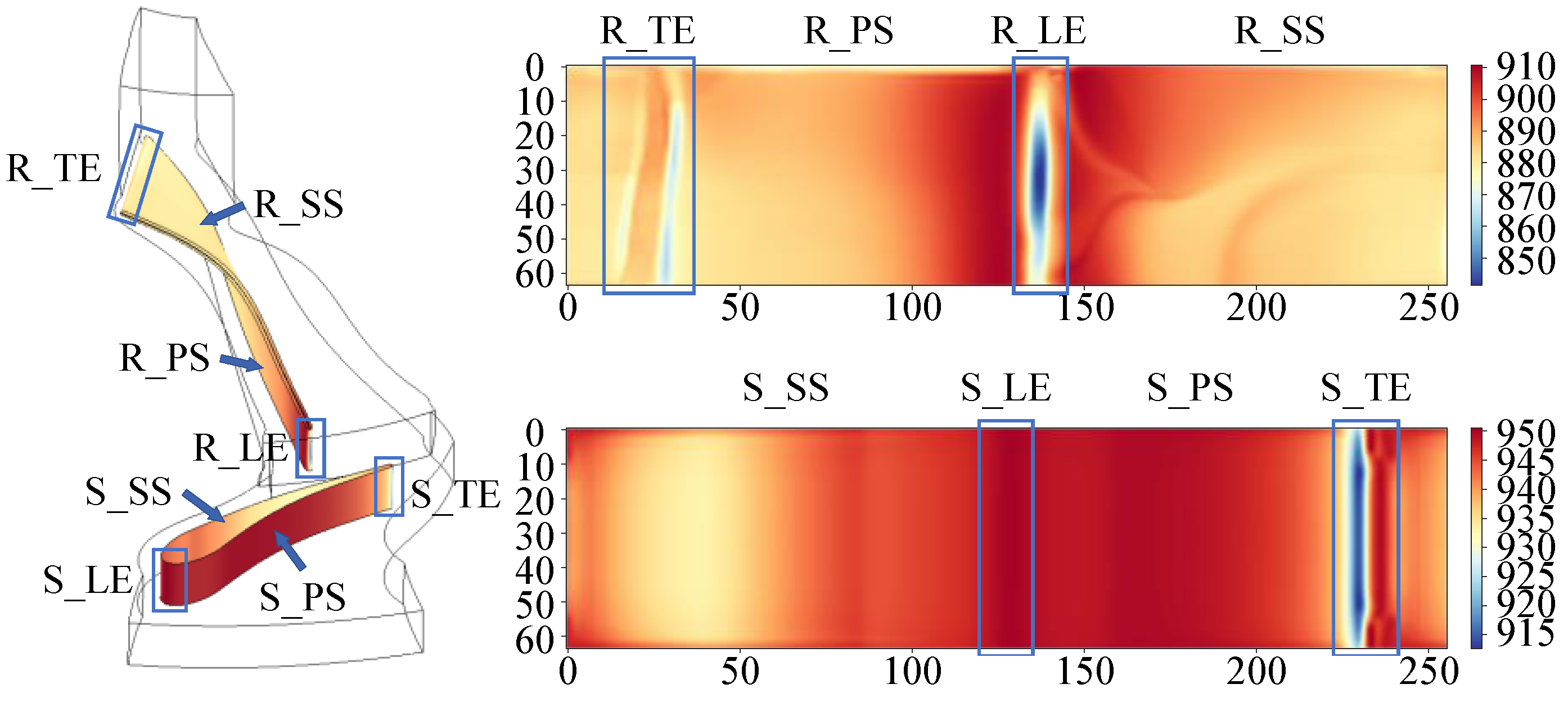
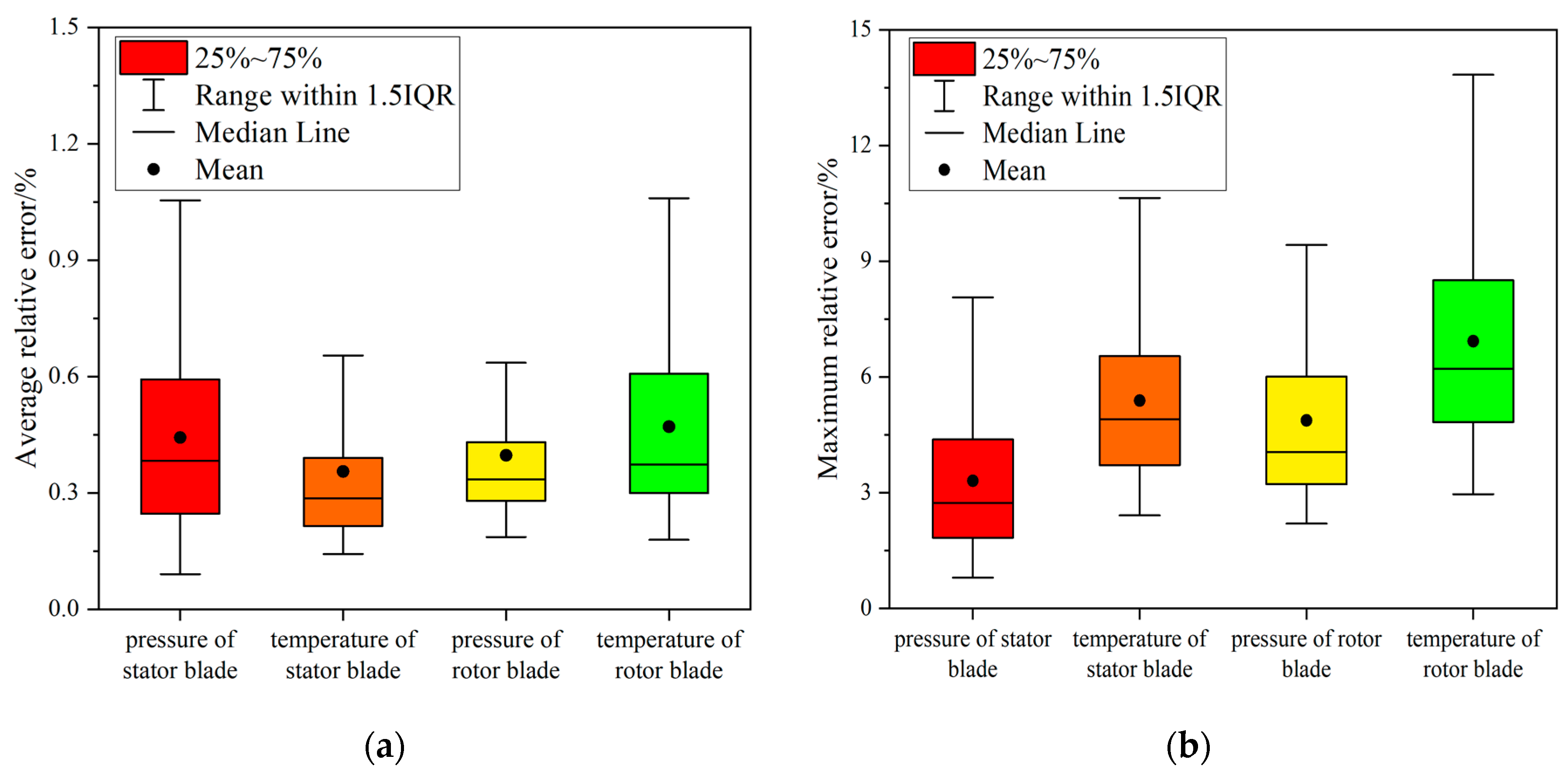
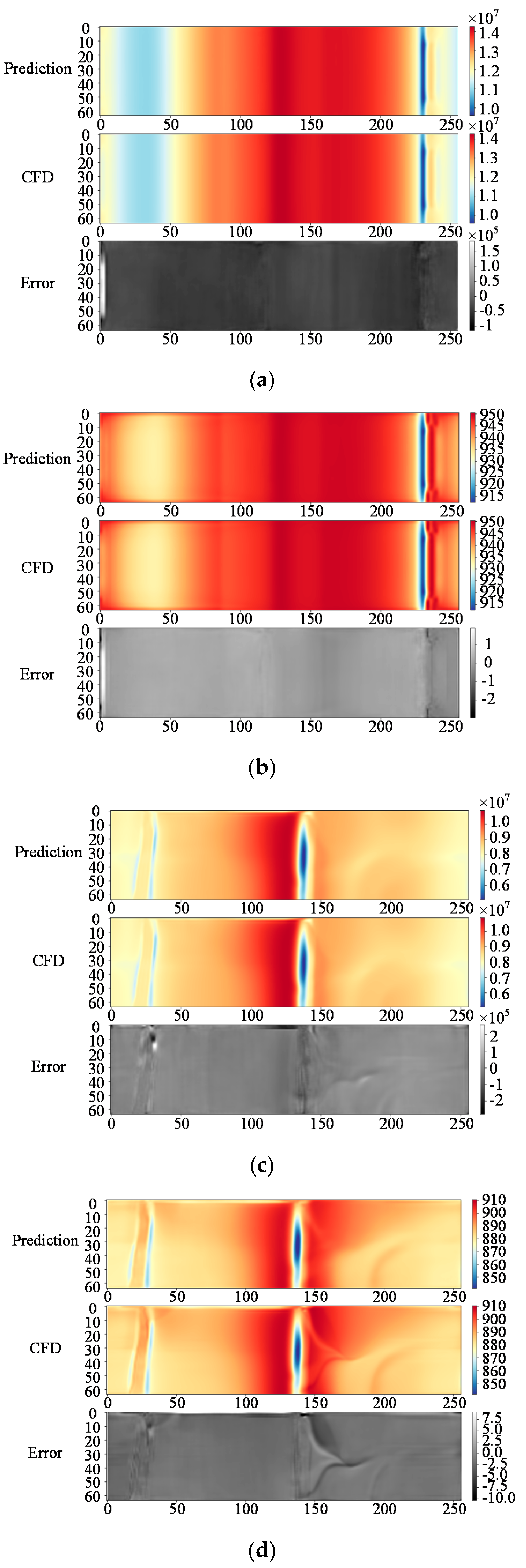
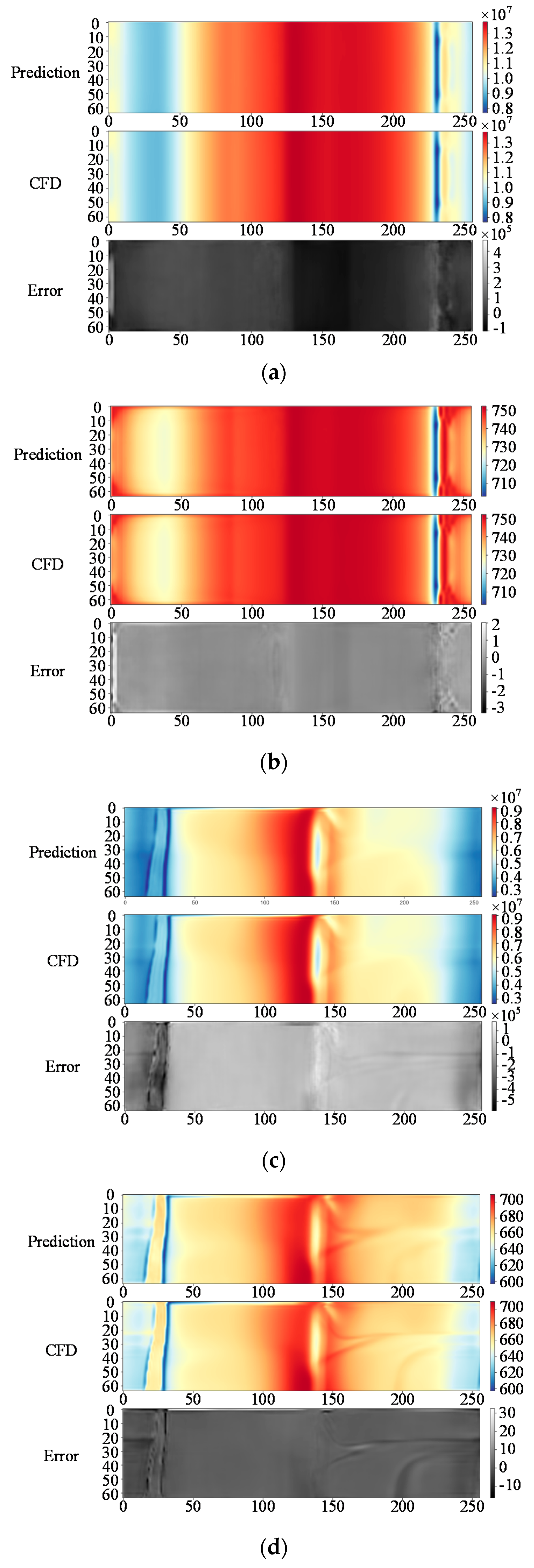
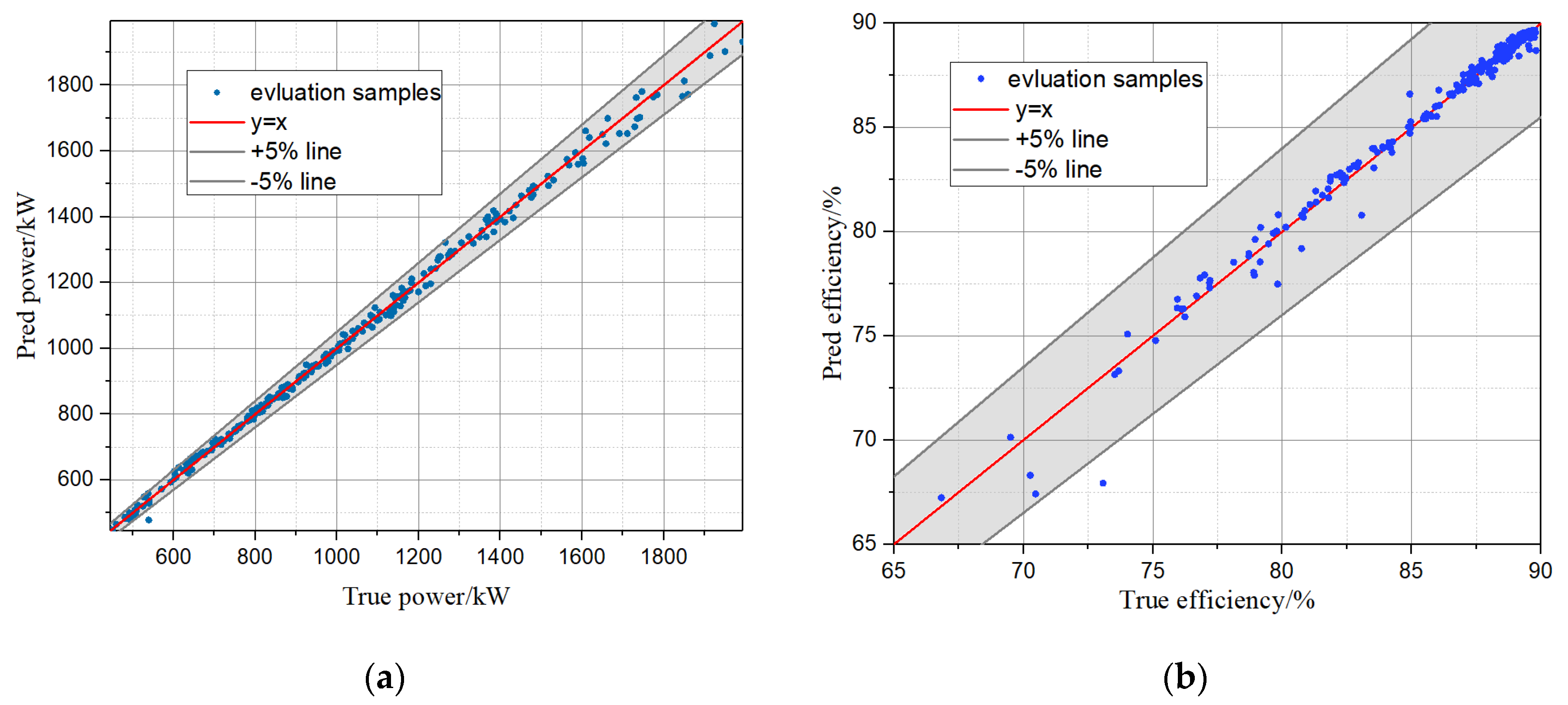
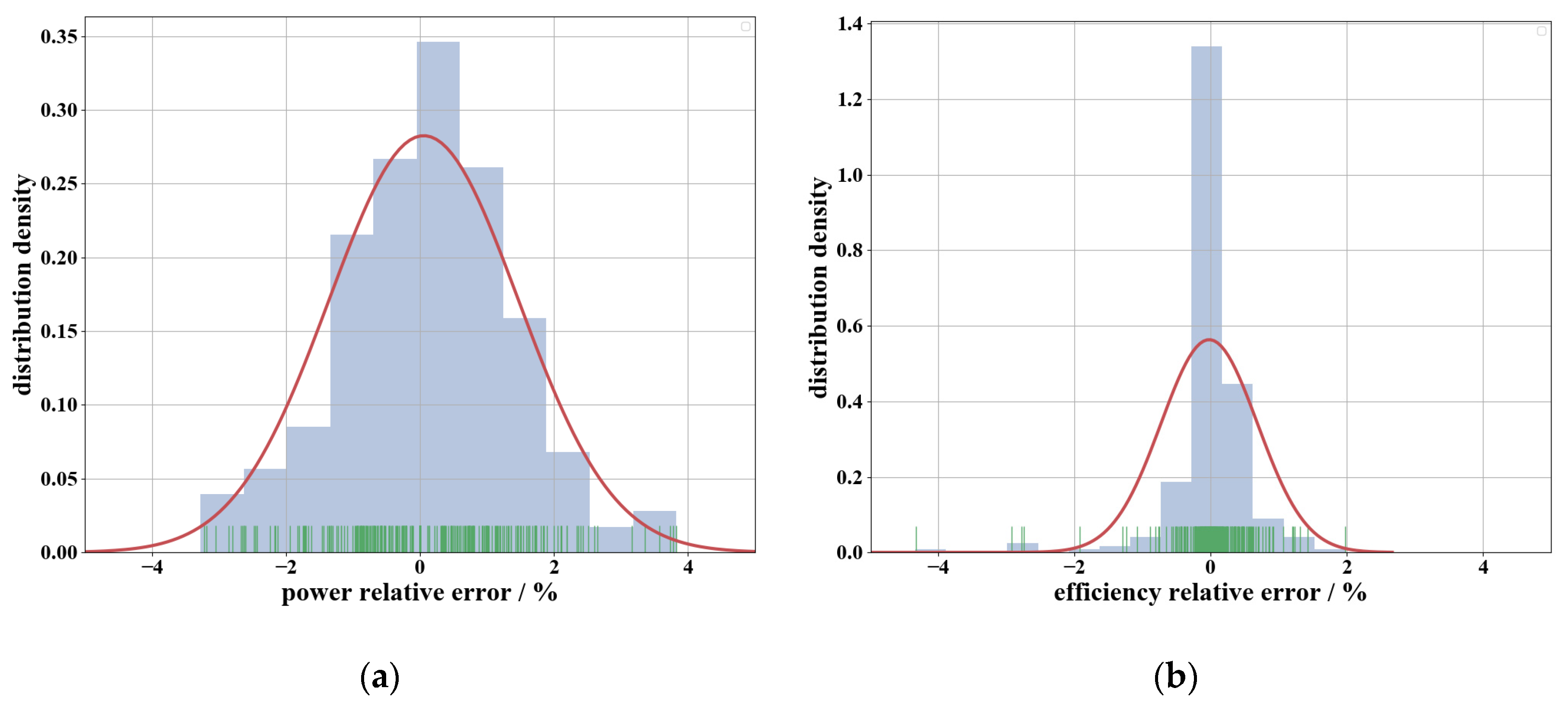
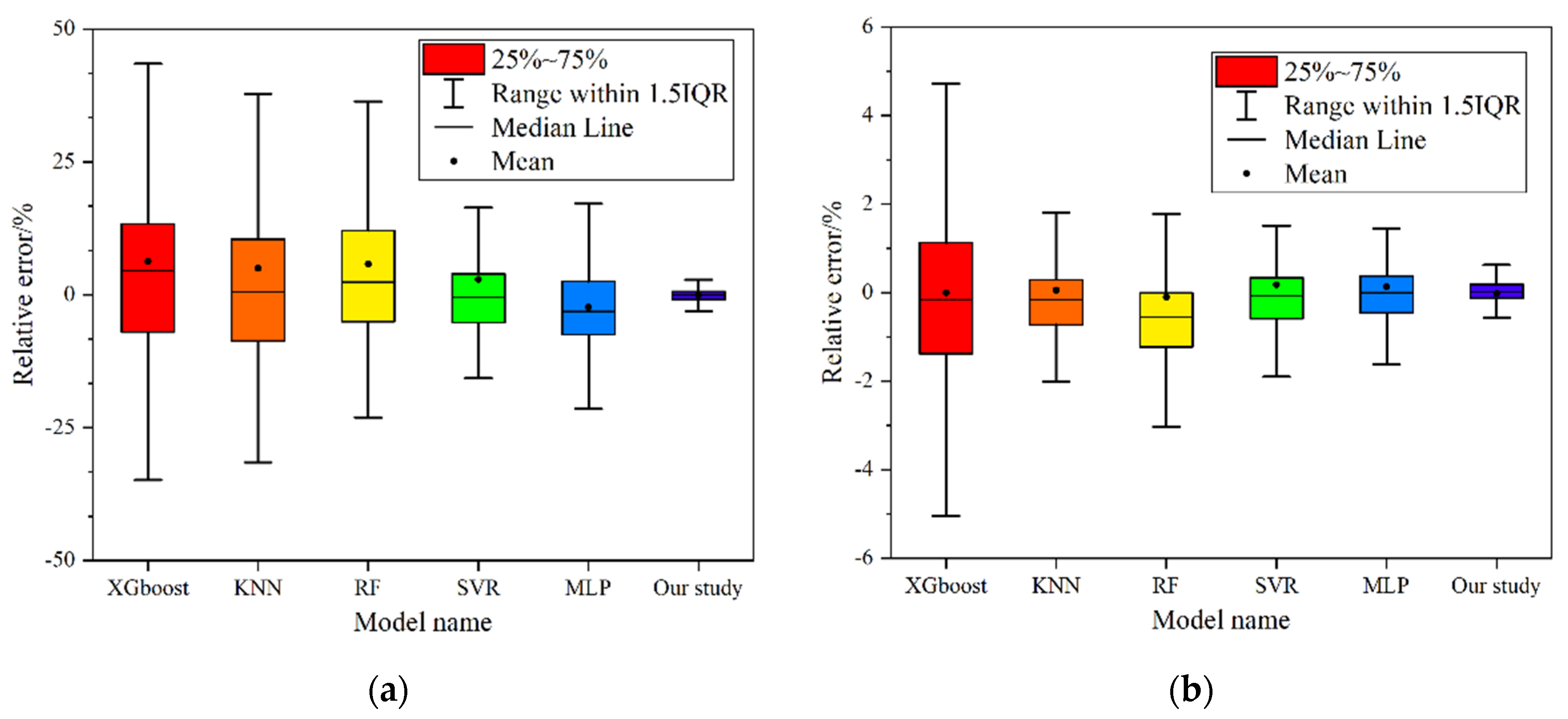
| Layers | Stage 1: Field Reconstruction Model | Stage 2: Performance Prediction Model | ||
|---|---|---|---|---|
| Basic Block | Shortcut | Basic Block | Shortcut | |
| Input size | Batch Size × 5 (number of design variables) | Stator blade: Batch Size (64) × grid size (36 × 104) Rotor blade: Batch Size (64) × grid size (51 × 232) | ||
| Input layer | Linear (in = 5, out = 8192) | Interpolation (Batch Size × 256 × 64 × 4) Conv2d (k = 3, s = 1, c = 32) | ||
| Layer 1 | Deconv2d (k = 3, s = 2, c = 512 Deconv2d (k = 3, s = 1, c = 512) | Deconv2d (k = 3, s = 2, c = 512) | Conv2d (k = 3, s = 1, c = 64) Conv2d (k = 3, s = 1, c = 64) | Conv2d (k = 3, s = 2, c = 64) |
| Layer 2 | Deconv2d (k = 3, s = 2, c = 256) Deconv2d (k = 3, s = 1, c = 256) | Deconv2d (k = 3, s = 2, c = 256) | Conv2d (k = 3, s = 2, c = 128) Conv2d (k = 3, s = 1, c = 128) | Conv2d (k = 3, s = 2, c = 128) |
| Layer 3 | Deconv2d (k = 3, s = 2, c = 128) Deconv2d (k = 3, s = 1, c = 128) | Deconv2d (k = 3, s = 2, c = 128) | Conv2d (k = 3, s = 2, c = 256) Conv2d (k = 3, s = 1, c = 256) | Conv2d (k = 3, s = 2, c = 256) |
| Deconv2d (k = 3, s = 1, c = 128) Deconv2d (k = 3, s = 1, c = 128) | / | Conv2d (k = 3, s = 1, c = 256) Conv2d (k = 3, s = 1, c = 256) | / | |
| Layer 4 | Deconv2d (k = 3, s = 2, c = 64) Deconv2d (k = 3, s = 1, c = 64) | Deconv2d (k = 3, s = 2, c = 64) | Conv2d (k = 3, s = 2, c = 512) Conv2d (k = 3, s = 1, c = 512) | Conv2d (k = 3, s = 2, c = 512) |
| Deconv2d (k = 3, s = 1, c = 64) Deconv2d (k = 3, s = 1, c = 64) | / | |||
| Layer 5 | Deconv2d (k = 3, s = 2, c = 32) Deconv2d (k = 3, s = 1, c = 32) | Deconv2d (k = 3, s = 2, c = 32) | Conv2d (k = 3, s = 2, c = 1024) Conv2d (k = 3, s = 1, c = 1024) | Conv2d (k = 3, s = 2, c = 1024) |
| Layer 6 | Deconv2d (k = 3, s = 1, c = 16) Deconv2d (k = 3, s = 1, c = 16) | Deconv2d (k = 3, s = 1, c = 16) | AvgPool2d (k = 3, s = 3) | |
| Output layer | Conv2d (k = 3, s = 1, c = 4) Interpolation (256 × 64) | Linear (in = 5120, out = 256) Linear (in = 256, out = 2) | ||
| Output size | Stator blade: Batch Size (64) × grid size (36 × 104) Rotor blade: Batch Size (64) × grid size (51 × 232) | Batch Size × 2 (number of performance) | ||
| Parameter Type | Parameter | Value | Unit |
|---|---|---|---|
| Thermodynamic parameter | Inlet temperature | 600 | °C |
| Inlet pressure | 15 | MPa | |
| Outlet pressure | 8 | MPa | |
| Design power | 1000 | kW | |
| Rotating speed | 60,000 | rpm | |
| Geometric parameter | Number of stator blades | 16 | pc. |
| Stator inner diameter | 119.7 | mm | |
| Stator outer diameter | 153.2 | mm | |
| Number of rotor blades | 15 | pc. | |
| Impeller inlet blade height | 6 | mm | |
| Impeller outer diameter | 99.7 | mm | |
| Impeller outlet blade height | 15.9 | mm | |
| Tip clearance | 0.2 | mm | |
| Performance parameter | Mass flow rate | 11.38 | kg/s |
| Torque | 162.2 | N·m | |
| Numerical power | 1019 | kW | |
| Isentropic enthalpy drop | 1139 | kJ/kg | |
| Total static efficiency | 89.44 | % | |
| Blade profile | 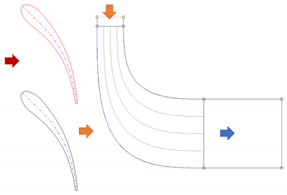 | ||
| Stator (blade to blade) Rotor (Meridional plan) | |||
| Method | Physical Memory | Graphics Memory | Train Time | Evaluation Time |
|---|---|---|---|---|
| CFD solver | 730–1730 Mb | / | / | 3.5 h |
| Our study—CPU | 1975–2975 Mb | / | 24 h | 0.24 s |
| Our study—GPU | 2787–3787 Mb | 1785–2385 Mb | 4–5 h | 0.04 s |
| Model | XGboost | KNN | RF | SVR | MLP | Our Study |
|---|---|---|---|---|---|---|
| R2 | 0.6784 | 0.7020 | 0.7446 | 0.8447 | 0.9072 | 0.9851 |
| MAE | 0.0184 | 0.0133 | 0.0148 | 0.0076 | 0.0066 | 0.0027 |
| RMSE | 0.0297 | 0.0288 | 0.0267 | 0.0208 | 0.0161 | 0.0054 |
© 2020 by the authors. Licensee MDPI, Basel, Switzerland. This article is an open access article distributed under the terms and conditions of the Creative Commons Attribution (CC BY) license (http://creativecommons.org/licenses/by/4.0/).
Share and Cite
Shi, D.; Sun, L.; Xie, Y. Off-Design Performance Prediction of a S-CO2 Turbine Based on Field Reconstruction Using Deep-Learning Approach. Appl. Sci. 2020, 10, 4999. https://doi.org/10.3390/app10144999
Shi D, Sun L, Xie Y. Off-Design Performance Prediction of a S-CO2 Turbine Based on Field Reconstruction Using Deep-Learning Approach. Applied Sciences. 2020; 10(14):4999. https://doi.org/10.3390/app10144999
Chicago/Turabian StyleShi, Dongbo, Lei Sun, and Yonghui Xie. 2020. "Off-Design Performance Prediction of a S-CO2 Turbine Based on Field Reconstruction Using Deep-Learning Approach" Applied Sciences 10, no. 14: 4999. https://doi.org/10.3390/app10144999
APA StyleShi, D., Sun, L., & Xie, Y. (2020). Off-Design Performance Prediction of a S-CO2 Turbine Based on Field Reconstruction Using Deep-Learning Approach. Applied Sciences, 10(14), 4999. https://doi.org/10.3390/app10144999




